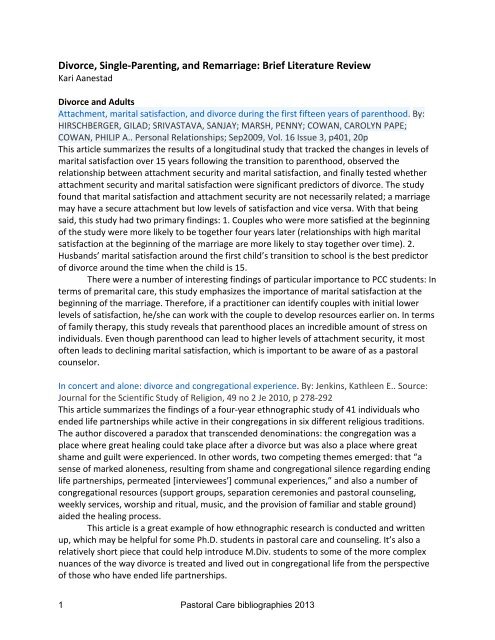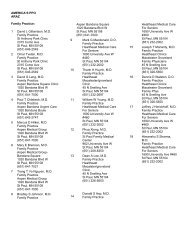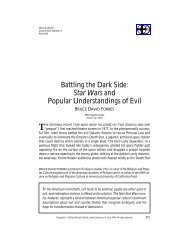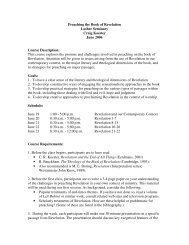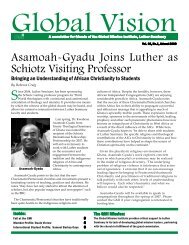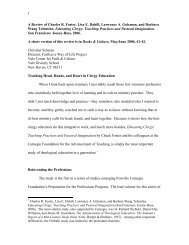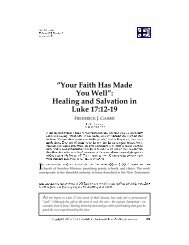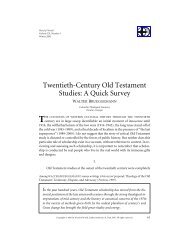Divorce, Single-Parenting, and Remarriage: Brief Literature Review
Divorce, Single-Parenting, and Remarriage: Brief Literature Review
Divorce, Single-Parenting, and Remarriage: Brief Literature Review
You also want an ePaper? Increase the reach of your titles
YUMPU automatically turns print PDFs into web optimized ePapers that Google loves.
<strong>Divorce</strong>, <strong>Single</strong>-<strong>Parenting</strong>, <strong>and</strong> <strong>Remarriage</strong>: <strong>Brief</strong> <strong>Literature</strong> <strong>Review</strong>Kari Aanestad<strong>Divorce</strong> <strong>and</strong> AdultsAttachment, marital satisfaction, <strong>and</strong> divorce during the first fifteen years of parenthood. By:HIRSCHBERGER, GILAD; SRIVASTAVA, SANJAY; MARSH, PENNY; COWAN, CAROLYN PAPE;COWAN, PHILIP A.. Personal Relationships; Sep2009, Vol. 16 Issue 3, p401, 20pThis article summarizes the results of a longitudinal study that tracked the changes in levels ofmarital satisfaction over 15 years following the transition to parenthood, observed therelationship between attachment security <strong>and</strong> marital satisfaction, <strong>and</strong> finally tested whetherattachment security <strong>and</strong> marital satisfaction were significant predictors of divorce. The studyfound that marital satisfaction <strong>and</strong> attachment security are not necessarily related; a marriagemay have a secure attachment but low levels of satisfaction <strong>and</strong> vice versa. With that beingsaid, this study had two primary findings: 1. Couples who were more satisfied at the beginningof the study were more likely to be together four years later (relationships with high maritalsatisfaction at the beginning of the marriage are more likely to stay together over time). 2.Husb<strong>and</strong>s’ marital satisfaction around the first child’s transition to school is the best predictorof divorce around the time when the child is 15.There were a number of interesting findings of particular importance to PCC students: Interms of premarital care, this study emphasizes the importance of marital satisfaction at thebeginning of the marriage. Therefore, if a practitioner can identify couples with initial lowerlevels of satisfaction, he/she can work with the couple to develop resources earlier on. In termsof family therapy, this study reveals that parenthood places an incredible amount of stress onindividuals. Even though parenthood can lead to higher levels of attachment security, it mostoften leads to declining marital satisfaction, which is important to be aware of as a pastoralcounselor.In concert <strong>and</strong> alone: divorce <strong>and</strong> congregational experience. By: Jenkins, Kathleen E.. Source:Journal for the Scientific Study of Religion, 49 no 2 Je 2010, p 278-292This article summarizes the findings of a four-year ethnographic study of 41 individuals whoended life partnerships while active in their congregations in six different religious traditions.The author discovered a paradox that transcended denominations: the congregation was aplace where great healing could take place after a divorce but was also a place where greatshame <strong>and</strong> guilt were experienced. In other words, two competing themes emerged: that “asense of marked aloneness, resulting from shame <strong>and</strong> congregational silence regarding endinglife partnerships, permeated [interviewees’] communal experiences,” <strong>and</strong> also a number ofcongregational resources (support groups, separation ceremonies <strong>and</strong> pastoral counseling,weekly services, worship <strong>and</strong> ritual, music, <strong>and</strong> the provision of familiar <strong>and</strong> stable ground)aided the healing process.This article is a great example of how ethnographic research is conducted <strong>and</strong> writtenup, which may be helpful for some Ph.D. students in pastoral care <strong>and</strong> counseling. It’s also arelatively short piece that could help introduce M.Div. students to some of the more complexnuances of the way divorce is treated <strong>and</strong> lived out in congregational life from the perspectiveof those who have ended life partnerships.1 Pastoral Care bibliographies 2013
more stressful than their mother’s. The discussion section of this paper could be a very helpfulresource in a pastoral care <strong>and</strong> counseling class.Twenty Major Issues in <strong>Remarriage</strong> Families. By: Walsh, William M.. Journal of Counseling &Development; 70(6): pp. 709-715; Jul/Aug 1992, 7pThis article surveys the current literature on remarriage in families <strong>and</strong> identifies 20 majorissues present, organized into four categories: (1) Initial Family Stress - name for the newparent, affection for the new parent <strong>and</strong> absent parent, loss of the natural parent, instant loveof new family members, fantasy about old family structure; (2) Developing Family Issues -discipline by the stepparent, confusion over family roles, sibling conflict, competition for time,extended kinship network, sexual conflicts, changes over time, exit <strong>and</strong> entry of children; (3)Feelings About Self <strong>and</strong> Others - society’s concept of the remarriage family, familial selfconcept,individual self concept; (4) Adult Issues - effects of parenting on the new maritalrelationship, financial concerns, continuing adult conflict, competition of the noncustodialparent.<strong>Single</strong>-<strong>Parenting</strong>Developmental Issues Impacting Military Families With Young Children During <strong>Single</strong> <strong>and</strong>Multiple Deployments. By: Barker, Lisa Hains; Berry, Kathy D.. Military Medicine; Oct2009, Vol.174 Issue 10, p1033, 8p.This article researched 57 families with at least one young child to study how children areaffected by single <strong>and</strong> multiple Operation Iraqi Freedom (OIF) <strong>and</strong> Operation EnduringFreedom (OEF) deployments. Though there are some self-reported weaknesses to the study,the findings affirmed what most pastoral caregivers might suspect: children with a deployedparent showed increased behavior problems during deployment <strong>and</strong> increased attachmentbehaviors when reunited with the deployed parent (ie. “ Home discipline problems, sadness,<strong>and</strong> increased dem<strong>and</strong>s for attention may be present in as many as 25-50% of children youngerthan 5 with a deployed parent”). I found the article to be an interesting segue into one facet ofsingle-parenting <strong>and</strong> family stress that is not always as prevalent as other issues.Prevalence of Psychiatric Disorder in Lone Fathers <strong>and</strong> Mothers: Examining the Intersection ofGender <strong>and</strong> Family Structure on Mental Health. By: Wade, Terrance J.; Veldhuizen, Scott;Cairney, John. Canadian Journal of Psychiatry; Sep2011, Vol. 56 Issue 9, p567, 7pThis article identified a lack of research on the effects of family structure (namely singleparenthood)on fathers. Using the Canadian Community Health Survey: Mental Health <strong>and</strong>Well-Being for data, the study analyzed 769 lone fathers. The article reports that lone fathersare at greater risk for psychiatric disorders (ie. depression, mania, panic, <strong>and</strong> substance usedisorders) than married parents <strong>and</strong> are less likely to seek mental health care. This article,though focusing on fathers, emphasizes that being a lone parent (both mothers <strong>and</strong> fathers) is adisadvantaged social status, <strong>and</strong> lone parents show significantly higher rates of psychiatricdisorder compared to their married counterparts.3 Pastoral Care bibliographies 2013


